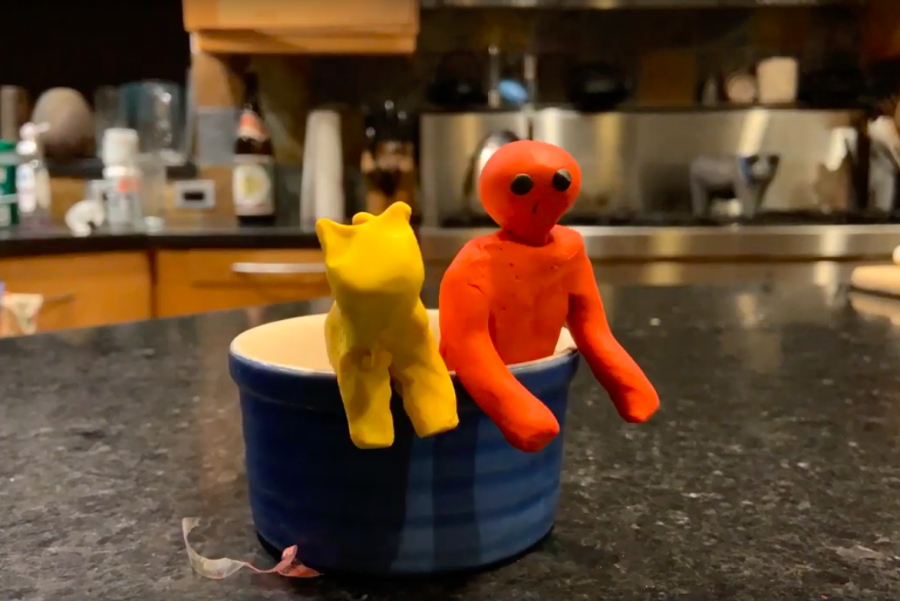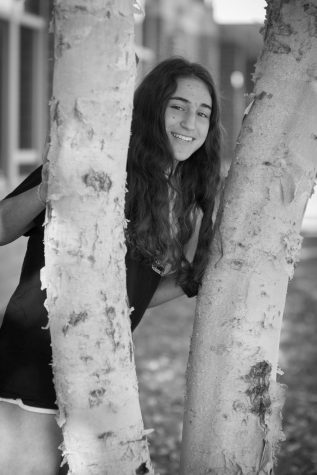Yellow cats and red men: Rediscovering my passion for claymation
A yellow clay cat and a red clay man stand in a bowl. I wanted to challenge myself and rediscover my passion for claymation, so I directed my own claymation movie.
April 5, 2020
When my mom yelled “You’re so boring!” at me a few weeks ago, adding “You don’t have any hobbies,” I was mad. After all, isn’t school a hobby? But after thinking about it for a few minutes, I realized something: She was right.
When I was little, I had so many after school activities. I played soccer, took art classes, took guitar lessons, went to Hebrew school and read all the time.
One of my more obscure interests was claymation. I found the unconventional activity the conventional way: I downloaded a stop-motion app on my iPod Touch 3 and I made countless movies with my playmobil, LEGOs and plastic animals. My friends and I would even have stop-motion competitions to see who could make the most flawless video of a plastic dinosaur gliding across a shag carpet (I would usually claim victory). After a few years of messy homemade videos, I signed up for a claymation camp at Glen Echo Park when I was 12.
On the first day of camp, we sculpted our characters. We spent the rest of the week working together as a class to film the thrilling story of an alien who had infiltrated a beach. Each camper’s character was a part of the movie, and everyone took turns moving the pieces in between shots and creating sound effects. I remember being so proud when my character had a line in the movie.
I fell in love with claymation at that camp. But during seventh grade, I became busy with bat mitzvah preparation and quickly lost sight of my claymation dreams. So this year, to rediscover my passion — and to get my mom off my back — I decided to challenge myself. I was going to direct my own claymation movie.
DAY 1:
I was excited to indulge in a childhood hobby. I had a lingering thought in my mind that I would maybe make a masterpiece and find a new career, but before I could begin, I had to buy some clay. I went to Plaza Artist Materials & Picture Framing to purchase the necessities: two large packets of clay. After I came home, it was time to shine. But my claymation ideas didn’t come as easily as they had before.
I sat in my rat-infested basement for 30 minutes thinking about what I was supposed to do.
Slowly, I created my set: a white shoebox and a LEGO structure I made to stabilize my phone. I had no plot and no knowledge of my current skills or limitations, but I decided to dive right in and see where the clay would take me.
I started out with a blob of yellow clay. I opened up the “Stop Motion” app on my phone and set it in the LEGO stabilizer. Every time I took a picture, the screen showed the transparent image of the picture I just took, so I could judge the frame and make sure the camera didn’t move. I set an interval timer so the app automatically took pictures every few seconds.
I started out with a blank set. Then, after every picture, a blob of yellow clay would move farther and farther into the frame. I tried to make the blob look like it was rolling, but the yellow clay wouldn’t stay in the positions I placed it in. Simply put, it was frustrating.
Once the blob made it to the center of the screen, I had absolutely no idea what to do next. I decided to split the clay blob in half. For each frame, I would pick up the clay and make a bigger and bigger indent until it was two separate blobs.
After I finished for the day, I watched the results — a whole 6 seconds of footage from my 40 minutes of work.
The shadows were inconsistent and my thumb was in a quarter of the shots, but it was already dark outside so I decided I should take the night to reflect.
DAY 2:
I was feeling very confident and creative. I sat at the table and placed my phone into the stabilizer, carefully matching the position with the last shot. I sculpted two yellow men out of my blobs of clay, remembering the process from my claymation summer camp five years ago: make the body and legs out of one block of clay and cut out a “u” shape to make two legs. Although my clay-boys were short and bulky — and slightly pyramidal — I was proud of myself. I looked into the black dots of their eyes and prepared for production.
They were to walk into frame smoothly. I moved the legs in back and forth in between each frame, slowly moving them closer and closer to each other. But their legs kept falling off and they often tipped over from instability before I could take the picture. When I finally finished and watched the video, I was proud and relieved — the blobs of clay actually looked like they were walking.
I watched it over and over, and although it was sloppy, you could still roughly tell what was happening — even though my shadow moved with every shot. I showed all my friends the next day saying “this is my favorite part” during the walking scene.
DAY 3:
On my last day of the challenge, I decided to try something new. I ditched the basement, the white shoebox and the dirty yellow clay I’d been using exclusively. It was time for a new movie, a new set and new characters. I sculpted a red man and a yellow cat — show stopping, iconic, never been done before.
This time, when I tried to make him walk, it was a lot less daunting. I made his legs longer so they were easier to move in between each picture, but they still fell apart after each step. I also added a big LEGO truck as a prop so I didn’t have to make them walk the whole time. The cat sat in the driver’s seat, driving around my black counter-island road while the red man sat in a small bowl in the back of the truck. Although my storyline wasn’t very clear, the movements were more consistent. I watched the footage in awe as my man climbed out of the bowl and his body squished into a snake that slithered off screen.
Conclusion:
Though my movies weren’t top quality, I was proud of them — and proud of myself. The characters generally moved in a way that made sense, and I could see my improvement from the first movie to the second.
While making the movie, I remembered why I stopped making stop-motions in the first place: It was really hard. But, with practice, stop-motion gets easier and looks better. I learned how to handle the clay, to make the legs longer and use props.
Mostly, I remembered why I started: It was rewarding to watch something I created, and it brought me back to the days where the two things I loved most were making movies and playing with plastic animals.









